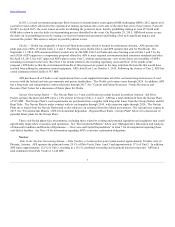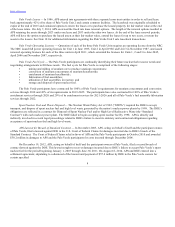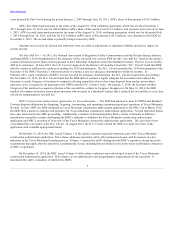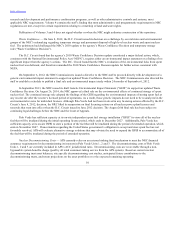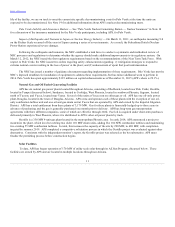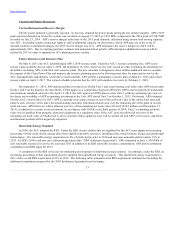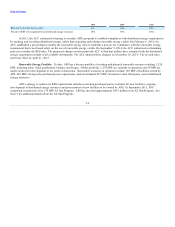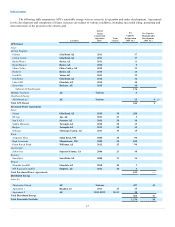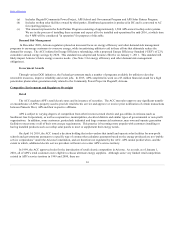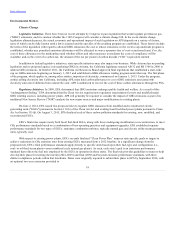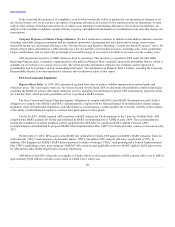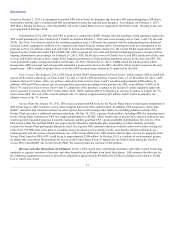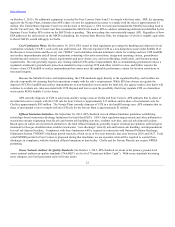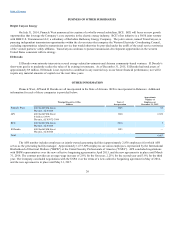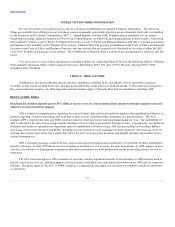APS 2015 Annual Report Download - page 20
Download and view the complete annual report
Please find page 20 of the 2015 APS annual report below. You can navigate through the pages in the report by either clicking on the pages listed below, or by using the keyword search tool below to find specific information within the annual report.
Table of Contents
currently no active retail competitors offering unbundled energy or other utility services to APS’s customers. In 2000, the Arizona
Superior Court found that the rules were in part unconstitutional and in other respects unlawful, the latter finding being primarily on
procedural grounds, and invalidated all ACC orders authorizing competitive electric services providers to operate in Arizona. In 2004,
the Arizona Court of Appeals invalidated some, but not all of the rules and upheld the invalidation of the orders authorizing competitive
electric service providers. In 2005, the Arizona Supreme Court declined to review the Court of Appeals’ decision.
In 2008, the ACC directed the ACC staff to investigate whether such retail competition was in the public interest and what legal
impediments remain to competition in light of the Court of Appeals’ decision referenced above. The ACC staff’s report on the results
of its investigation was issued on August 12, 2010. The report stated that additional analysis, discussion and study of all aspects of the
issue are required in order to perform a proper evaluation. While the report did not make any specific recommendations other than to
conduct more workshops, the report did state that the current retail electric competition rules are incomplete and in need of
modification.
On May 9, 2013, the ACC voted to re-examine the facilitation of a deregulated retail electric market in Arizona. The ACC
subsequently opened a docket for this matter and received comments from a number of interested parties on the considerations
involved in establishing retail electric deregulation in the state. One of these considerations was whether various aspects of a
deregulated market, including setting utility rates on a “market” basis, would be consistent with the requirements of the Arizona
Constitution. On September 11, 2013, after receiving legal advice from the ACC staff, the ACC voted 4-1 to close the current docket
and await full Arizona Constitutional authority before any further examination of this matter. The motion approved by the ACC also
included opening one or more new dockets in the future to explore options to offer more rate choices to customers and innovative
changes within the existing cost-of-service regulatory model that could include elements of competition. The ACC opened a docket on
November 4, 2013 to explore technological advances and innovative changes within the electric utility industry. A series of workshops
in this docket were held in 2014 and another in February of 2015. No further workshops are scheduled and no actions were taken as a
result of these workshops.
On January 28, 2016, an ACC Commissioner, Robert L. Burns, sent APS a Notice of Investigation pursuant to an Arizona
statute that authorizes a Commissioner and his agents to inspect the accounts, books, papers and documents of any public service
corporation, and examine under oath any officer, agent or employee of such corporation in relation to the business and affairs of the
corporation. The Notice states that Commissioner Burns intends to investigate whether APS has used funds recoverable from ratepayers
for political contributions, lobbying, or charitable donations purposes; whether APS’s corporate affiliates have made contributions or
donations under APS’ brand name; and the degree to which APS and Pinnacle West are “intertwined” in terms of organization,
management and operations. APS intends to cooperate with this investigation to the full extent that the matter is lawfully authorized, but
cannot predict its timing or outcome.
Wholesale
FERC regulates rates for wholesale power sales and transmission services. (See Note 3 for information regarding APS’s
transmission rates.) During 2015, approximately 5.2% of APS’s electric operating revenues resulted from such sales and services.
APS’s wholesale activity primarily consists of managing fuel and purchased power supplies to serve retail customer energy
requirements. APS also sells, in the wholesale market, its generation output that is not needed for APS’s Native Load and, in doing so,
competes with other utilities, power marketers and independent power producers. Additionally, subject to specified parameters, APS
hedges both electricity and fuels. The majority of these activities are undertaken to mitigate risk in APS’s portfolio.
17


